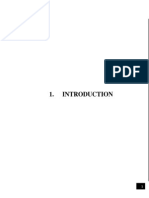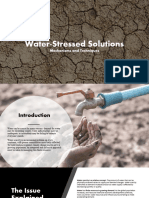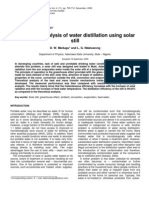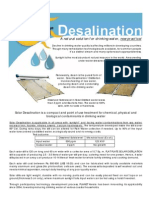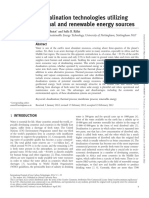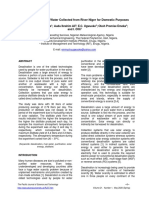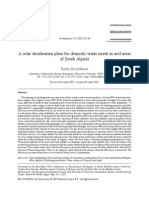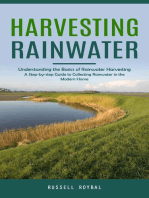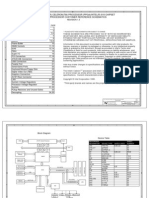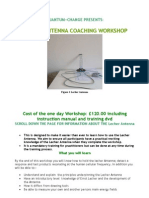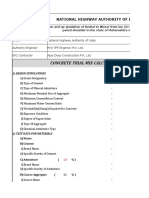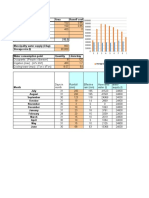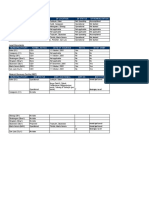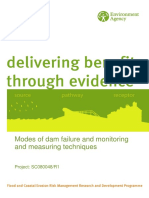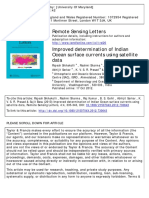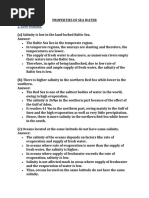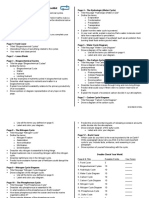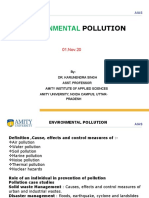Design and Performance Analysis of A Modified Vacuum Single Basin Solar Still
Design and Performance Analysis of A Modified Vacuum Single Basin Solar Still
Uploaded by
Raamesh GaikwaadCopyright:
Available Formats
Design and Performance Analysis of A Modified Vacuum Single Basin Solar Still
Design and Performance Analysis of A Modified Vacuum Single Basin Solar Still
Uploaded by
Raamesh GaikwaadOriginal Title
Copyright
Available Formats
Share this document
Did you find this document useful?
Is this content inappropriate?
Copyright:
Available Formats
Design and Performance Analysis of A Modified Vacuum Single Basin Solar Still
Design and Performance Analysis of A Modified Vacuum Single Basin Solar Still
Uploaded by
Raamesh GaikwaadCopyright:
Available Formats
Smart Grid and Renewable Energy, 2011, 2, 388-395
doi:10.4236/sgre.2011.24044 Published Online November 2011 (http://www.SciRP.org/journal/sgre)
Design and Performance Analysis of a Modified
Vacuum Single Basin Solar Still
Moses Koilraj Gnanadason1*, Palanisamy Senthil Kumar2, Gopal Sivaraman3,
Joseph Ebenezer Samuel Daniel4
1
Research Scholar, PRIST University, Thanjavur, India; 2Mechanical Engineering Department, KSR College of Engineering, Tiruchengode, India; 3Faculty of Mechanical Engineering, PAAVAI Group of Institutions, Pachel, India; 4Faculty of Mechanical Engineering, JACSI College of Engineering, Nazareth, India.
Email: *koiljemil@yahoo.co.in
Received July 26th, 2011; revised September 23rd, 2011; accepted September 30th, 2011.
ABSTRACT
Water is essential to life. The origin and continuation of mankind is based on water. The supply of drinking water is an
important problem for the developing countries. Among the non-conventional methods to desalinate brackish water or
seawater, is solar distillation. The solar still is the most economical way to accomplish this objective. Tamilnadu lies in
the high solar radiation band and the vast solar potential can be utilized to convert saline water to potable water. The
suns energy heats water to the point of evaporation. When water evaporates, water vapour rises leaving the impurities
like salts, heavy metals and condensate on the underside of the glass cover. Sunlight has the advantage of zero fuel cost
but it requires more space and generally more equipment. Solar distillation has low yield, but safe and pure supplies of
water in remote areas. In this context, the design modification of a single basin solar still has been discussed to improve
the solar still performance through increasing the production rate of distilled water. The attempts are also made to increase the productivity of water by using different absorbing materials, depths of water, heat storage medium and also
by providing low pressure inside the still basin. They greatly improve the rate of evaporation and hence the rate of
condensation on the cooler surface. The theoretical results agree well with the experimental ones.
Keywords: Solar Still, Design Modifications, Thermal Performance, Heat Storage
1. Introduction
Clean water is a basic human necessity and without water
life will be impossible. The provision of fresh water is
becoming an increasingly important issue in many areas
of the world. The increasing world population growth
together with increasing industrial and agricultural activities all over the world contributes to the depletion and
pollution of fresh water resources. Worldwide drought
and desertification are expected to increase the problem
[1]. The importance of supplying potable water can
hardly be overstressed. Water is an abundant natural resource that covers three quarters of the earths surface.
However, only about 3% of all water sources is potable.
Less than 1% fresh water is within human reach and the
rest is ice. Even this small fraction (ground water, lakes
and rivers) is believed to be adequate to support life and
vegetation on the earth. 30% of all fresh water is underground, most of it in deep, hard-to-reach aquifers. Lakes
and rivers together contain just a little more than 0.25%
Copyright 2011 SciRes.
of all fresh water; lakes contain most of it [2]. Remote
and arid regions depend on underground water for drinking. In arid areas potable water is very scarce and the
establishment of a human habitat in these areas strongly
depends on how such water can be made available. In
some instances, the salinity is probably too high for water to be considered as fresh drinking water; instead it is
called brackish water. The salinity of brackish water varies with locations. In such cases, fresh water has to be
either transported for long distances or connected with an
expensive distribution water network at extremely high
cost for a small population. Nowadays pollution in rivers
and lakes by industrial effluents and sewage disposal has
resulted in scarcity of fresh water in many big towns and
cities around the world [3].
One of the most important properties in such analysis
is salinity. Salinity is usually expressed in parts per million (ppm). The excessive brackishness causes problems
of taste, stomach problems and laxative effects. According to World Health Organization (WHO), the permissiSGRE
Design and Performance Analysis of a Modified Vacuum Single Basin Solar Still
ble limit of salinity in water is 500 ppm [4].
The rapid increasing need for energy and environmental concerns has focused much attention on renewable energy resources. The use of solar energy is more
economical than the use of fossil fuel in remote areas
having low population densities, low rain fall and abundant available solar energy. A simple solar still can easily
produce the water needed for drinking and cooking for
households without access to potable water. Also distilled water can be used for industrial purpose as it is
cleaner. It is a simple technology which can be operated
by non-skilled workers. Also due to the low maintenance
requirement, it can be used anywhere with lesser number
of problems. In solar desalination process, the productivity of the solar still is very less in the range of 2 - 5 litres/m2/day only compared to other conventional desalination systems. The problem is to enhance the amount of
water produced [5].
Various parameters affect both efficiency and productivity of the still. The distilled water production rate can
be increased by varying design of the solar still, depths of
water, salt concentration, location and different absorbing materials and evaporative techniques. In this context,
distilled water evaporation rate is enhanced by using solar still made up of Copper sheet instead of Cast Iron.
The attempts are also made to increase the productivity
of water by painting black coating inside the basin and
placing high solar thermal energy storage materials like
small pebbles inside the water to retain heat.
389
absorbed by the sea and causes water to evaporate. The
evaporated water rises above the earths surface and is
moved by the wind. Once this vapour cools down to its
dew point, condensation occurs, and the fresh water
comes down as rain as shown in Figure 1. The same
principle is used in all manmade distillation systems using alternative sources of heating and cooling. Working
of solar still is based on the simple scientific principle of
evaporation and condensation. There are several types of
solar stills, the simplest of which is the single basin still.
But the yield of this is low and falls in the range of 3 4litres per day per square metre [7]. Different still designs have been used in different regions globally, where
high quality drinking water supplies are scarce and the
solar option is viable. The operation of solar still is very
simple and no special skill is required for its operation
and maintenance.
2.2. Working of Solar Still
In conventional basin type solar still, the still consists of
a shallow airtight basin lined with a black, impervious
material, which contains brackish or saline water as shown
in Figure 2. Solar radiation received at the surface is
absorbed effectively by the black surface and heat is
transferred to the water in the basin. Temperature of the
water increases and it increases the rate of evaporation. A
sloping transparent cover is provided at the top. Water
vapour produced by evaporation rises upward and condenses on the inner surface of the glass cover which is
2. Solar Still
As the available fresh water is fixed on earth and its demand is increasing day by day due to increasing population and the rapid increase of industry, hence there is an
essential and earnest need to get fresh water from the
saline/brackish water present on or inside the earth. This
process of getting fresh water from saline/brackish water
can be done easily and economically by desalination.
Owing to the diffuse nature of solar energy, the main
problems with the use of solar thermal energy in largescale desalination plants are the relatively low productivity rate, the low thermal efficiency and the considerable
land area required. Apart from the cost implications,
there are environmental concerns with regard to the burning of fossil fuels [6]. Solar energy can directly or indirectly be harnessed for desalination. The solar stills are
simple and have no moving parts.
Figure 1. Priciple of desalination.
2.1. Priciple of Desalination
Desalination is one of the most important methods of
getting potable water from brackish and sea water by
using the free energy supply from the sun. In nature, solar desalination produces rain when solar radiation is
Copyright 2011 SciRes.
Figure 2. Skeleton of solar still.
SGRE
390
Design and Performance Analysis of a Modified Vacuum Single Basin Solar Still
relatively cold. Condensed water vapour trickles down
into the trough and from there it is collected in the storage container as distilled water.
The distilled water from a solar still has excellent taste
when compared with commercially distilled water since
the water is not boiled (which lowers pH). This allows
for natural pH buffering that produces excellent taste as
compared to steam distillation. Solar stills can easily
provide enough water for the drinking and cooking needs
of the family. They are made of quality materials designed to stand up to the harsh conditions produced by
water and sunlight. Water may be added through the
still's supply fill port. Purified drinking water is collected
from the output collection port as distillate.
3. Experimental Setup
3.1. Solar Still Made Up of Copper
It should be noted that before considering the application
of any desalination method, water conservation measures
should be considered first. In the recent years, a number
of models for solar distillation have been presented in
literature by various investigators. Mainly, they have
single and double slope solar collectors.
As shown in Figure 3, the solar still consists of a shallow triangular basin made up of Copper sheet instead of
G.I Sheet. As Copper has higher thermal conductivity of
395 W/mK comparatively higher than Iron, the rate of
heat transfer to water in the still is more. The bottom of
the basin is usually painted black to absorb the suns heat
which in turn increases the evaporation rate. The top of
Figure 3. Experimental setup.
Copyright 2011 SciRes.
the basin is covered with a glass of 4mm thick. Tilted
fixed 32 so as to allow maximum transmission of solar
radiation and helps the condensed vapour to trickle down
into the trough, built in channel in the still basin. The
edge of the glass is sealed with a tar tape so as to make
the basin airtight. The entire assembly is placed on a
stand structure made up of M.S angles. The outlet is connected to a storage container through a pipe. Provision is
made to change water in the stills. The still is filled with
the brackish water in a thin layer.
The basin liner is made of a copper sheet of 900 400
50 mm and 1.5 mm thickness. The copper sheet is
painted by red-lead primer then by matt-type black paint.
There are certain specifications needed for the glass
cover used in the still. They have a minimum amount of
heat absorption, minimum amount of reflection for solar
radiation energy, maximum transmittance for solar radiation energy, and high thermal resistance for heat loss
from the basin to the ambient.
Glass cover has been sealed with silicon rubber which
plays an important role to promote efficient operation as
it can accommodate the expansion and contraction between dissimilar materials. A thermo cool of 2.5 cm
thickness with thermal conductivity of 0.045 W/mK is
used as insulating material to reduce the heat losses from
the bottom and the side walls of the solar still. A small
feeding tank is installed in the system as a constant head
tank which is used to maintain the level of water inside
the still basin constant by a floating ball. The outer box is
made up of plywood.
Figure 4 and Figure 5 show the setup with and without heat storage medium (stones) of the still basin. To
absorb and retain the heat obtained by solar radiation,
heat absorbing materials like stones are placed inside the
still. Various aspects such as temperature and productivity are to be measured once every hour. And also the
percentage of salt concentration is added to water like
0%, 10%, and 20% depending upon the water depth in
the still basin. For different depths of water levels of basin 1 cm, 3 cm and 5 cm, readings are taken to find the
variation in yield.
Figure 4. Still with heat storage.
SGRE
Design and Performance Analysis of a Modified Vacuum Single Basin Solar Still
391
Table 1. Specification.
Figure 5. Still without heat storage.
The evaporation rate of the water in the solar still is directly proportional to the exposure area of water in the
still, absorber area and temperature of water in the basin.
Pebble is one of the highest solar thermal energy storage
materials as it has high sensible heat. A pebble of uniform diameter 10 mm is used. Addition of pebbles in the
basin surface increases the water temperature thereby
increasing the evaporation rate. The area productivity of
the solar still increases with the increase in absorber area.
3.2. Specifications
The materials selection and design specification of the
solar still is shown in Table 1. The material used for still
basin is Copper sheet because of its higher thermal conductivity. To transmit the maximum solar radiation to the
basin water, Glass is used as top cover. Thermo cool is
used as an insulating material to reduce heat transfer rate
and also it is economical. Plywood is used as outer cover
to keep the still basin inside.
3.3. Measurements
The solar still made up of Copper, inside bottom black
colour coated is operated from 6:00 am to 6:00 pm during the months of April and May 2011. The measurements of the temperatures, solar radiation intensity, and
the production of distilled water are taken hourly to study
the effect of each parameter on the still productivity. In
this study various operating conditions have been examCopyright 2011 SciRes.
Parts
name
Material
Size
Purpose of
selection
Still outer
box
plywood
1130 500 650
mm
Low cost and
stability
Still
Basin
Copper
sheet
400 900 60 mm
Thickness 1.5 mm
High heat
conductivity
Top Glass
Cover
Glass
1230 500 4 mm
High
transmitivity
Thermo
cool
Thermo
cool
25 mm thick
Insulation,
low cost
ined such as; different water depth, insulation thickness,
ambient temperature and salt concentration with and
without heat storage medium stones inside the till. The
variables such as Tg in, Tg out, Ta, Tw, Tp and productivity
are measured hourly.
The total productivity and solar Intensity for each day
are also measured. Also, different experimental tests are
carried out at different ambient conditions. From about 2
pm, water temperature decreases due to the loss from the
solar still which becomes larger than the absorbed solar
radiation. It can be noted that the basin temperature gets
closer to the water temperature because of the continuous
contact between them which leads to heat equilibrium.
As the glass temperature is much lower than the vapour temperature, it causes condensation of vapour on
the glass. In the early hours of the morning (8 - 9 am),
the glass temperature is higher than the water and vapour
temperatures causing small productivity due to the small
energy absorbed by the water at these times. There is
increase in the solar intensity in the early morning until it
reaches the maximum at around 12 to 2 pm, and then it
decreases in the late afternoon. The solar intensity has an
important effect on the solar still productivity. As the
solar intensity increases, the productivity increases due to
the increase in heat gain for water vaporization inside the
still.
The productivity rate varies as time passes from the
early morning until late afternoon. In the morning, the
temperature of water is low; therefore it needs high energy to change its phase from saturated liquid to saturated vapour phase. The results show that temperature
and required heat are inversely proportional. In the early
afternoon the temperature of water reaches the maximum
so it needs less heat to vaporize, and vice versa in the late
afternoon.
The same measurement process is repeated for various
parameters to find out the enhanced performance of the
copper still by using heat storage medium like small pebbles inside the still basin which helps to retain heat inside
the still. Pebble is one of the highest solar thermal energy
SGRE
392
Design and Performance Analysis of a Modified Vacuum Single Basin Solar Still
storage materials as it has high sensible heat. Addition of
pebbles in the basin surface increases the water temperature and thereby increasing the evaporation rate. The
productivity is significantly increased by black painting
and placing stones inside the still.
4. Modified Vacuum Solar Still
We all know that boiling takes place when the ambient
temperature equals that of the vapour pressure of the liquid. This means that we can increase the rate of evaporation by reducing the pressure of the still. This will ensure
higher rates of evaporation even at low temperatures. As
stated already, we need to reduce the working pressure
inside the distiller to increase the rate of evaporation at
lower temperatures and hence increase in efficiency. One
more additional feature in this still that we are proposing
is that it would use the latent heat which is released during condensation to heat up the water at lower temperature. This is achieved by using an innovative staged still
design as shown in Figure 6.
We are looking at the operating conditions of about
60C to ensure low heat transfer losses. At this temperature the vapour pressure of water is 20 KPa. So we need
to operate the pump to reduce the pressure to this value
and then leave it in the sun for distillation. This will ensure boiling of water inside the distiller as soon as the
temperature reaches 60C, which is pretty low and easily
achievable by using simple designs. In the design we
have incorporated a simple vacuum pump to reduce pressure inside the distillation chamber which will be operated intermittently to maintain the vacuum constantly. At
that time a separate condensation chamber is used to
condense the vapour leaving through the vacuum pump.
The same measurement process is repeated for various
parameters to find out the enhanced performance of the
vacuum still with and without heat storage pebbles and
compare the performance of them. Addition of pebbles in
the basin surface increases the water temperature and
thereby increasing the evaporation rate of the modified
vacuum still.
5. Theoretical Analysis
The energy received by the saline water in the still (from
the sun and base) is equal to the summation of energy
lost by convective heat transfer between water and glass,
radiative heat transfer between water and glass, evaporative heat transfer between water and glass, and energy
gained by the saline water:
I t aw Aw Qc b w
Qc w g Qr w g Qe w g mw c pw dT dt F
Following Dunkle (1961), the rate energy lost from
water surface by evaporation per m2 is given by
qew 0.0163 hcw pw pg
Nu
hcw d
n
C Gr Pr
k
The hourly distillate output per m2 from distiller unit is
given by
mw
qew
X 3600
L
n
k 3600
0.0163 pw pg
C Gr Pr
d L
mw
n
C Gr Pr
R
where
k 3600
R 0.0163 pw pg
d L
Pw = Partial pressure of saturated water
Pg= Partial pressure of glass saturated
hcw =heat loss coefficient by convection from water
surface to glass (W/m2 K)
The still efficiency is defined as the ratio of heat energy used for vaporizing the water in the basin to the
total Solar Intensity of radiation absorbed by the still.
The daily efficiency d is obtained by summing up the
hourly condensate production m, multiplied by the latent
heat of vaporization hfg, and divided by the daily average
solar radiation Ig over the still area A.
6. Discussion of Results
Brine
Figure 6. Vacuum solar still setup.
Copyright 2011 SciRes.
The Solar still made up of Copper is operated from 8.00
a.m to 5.00 p.m. The measurements of the temperatures,
solar radiation intensity and the production of distilled
water are taken hourly to study the effect of each parameter on the still productivity without using vacuum.
In this study, various operating conditions have been
SGRE
Design and Performance Analysis of a Modified Vacuum Single Basin Solar Still
examined such as different water depths; insulation thickness, salt concentration, ambient temperature and productivity are measured hourly. The output of the solar
still varies directly with the ambient temperature. The
area Productivity of the solar still increases with increase
in absorber area.
The productivity rate varies as time passes from the
early morning until late afternoon. The hourly output is
maximum in the afternoon hours when the ambient temperature is at its daily peak. The wind speed is found to
be around 2 - 4 m/s. The water temperature has a direct
effect on the productivity whereas the depth of water
increases from 2 to 3 and 5 cm, the daily still output decreases i.e. inversely proportional. The solar radiation is
absorbed by the black painting inside the bottom of the
basin and thus increases the temperature of the water In
this still, the productivity increases further due to the
increase in heat gain for water vaporization inside the
still because copper conducts more heat compared with
the still made up of Cast Iron. Due to this, the amount of
distillate collected in this still is higher and hence the
increase in efficiency by 80% when compared with the
still made up of Cast Iron for the same basin area.
In the copper still using heat storage medium like
small pebbles inside the still basin, same measurement
process is repeated to find out the enhanced performance
and compare them. Pebble is one of the highest solar
thermal energy storage materials as it has high sensible
heat. Addition of pebbles in the basin surface increases
the water temperature and thereby increasing the evaporation rate. Pebble of uniform diameter 10 mm is used.
The area Productivity of the solar still increases with
increase in absorber area. This improves the evaporation
rate and in turn improves the efficiency of the still to
certain extent. The average daily output is found to be 3
litres/day for the basin area of 0.36 m2 based on the data
of 8 days. The optimized glass cover angle is 32. The
efficiency is calculated as 100% higher comparable with
stills being used worldwide.
The same measurement process is repeated for various
parameters to find out the enhanced performance of the
vacuum still and compare the performance of them. This
reveals that an increase in the rate of evaporation by reducing the pressure of the still which will ensure higher
rates of evaporation even at low temperatures. Furthermore, this still uses the latent heat which is released during condensation to heat up the water at lower temperature. Due to this vacuum inside the still the evaporation
rate increases further and the efficiency further increases
by 50% compared with the still working at atmospheric
conditions. Also, it is more suitable for poor ambient
conditions as the still works at low pressure and evaporation of water takes place at a low temperature.
Copyright 2011 SciRes.
393
The same measurement process is repeated for various
parameters to find out the enhanced performance of the
modified vacuum still with pebbles and compare the performance of them. This reveals an increase in the rate of
evaporation by providing thermal storage medium which
will ensure higher thermal conduction between water and
the still. Due to this modification in vacuum still the
evaporation rate increases further and hence the increase
in efficiency by 20% in comparing with the vacuum still
6.1. Productivity vs Time with Various
Concentrations
For a solar still made up of copper without vacuum and
without gravels, Graphs are drawn for Productivity and
Time for various concentrations of 0%, 10% and 20%
and where different depths of water level of 1cm and
3cm. It reveals an increase in the productivity for minimum depths of water level as shown in Figure 7. It also
shows that the lower the salt concentrations the higher
will be the productivity as shown in Figure 8.
Figure 7. Productivity vs time for various concentrations.
Figure 8. Productivity vs time for various concentrations.
SGRE
394
Design and Performance Analysis of a Modified Vacuum Single Basin Solar Still
6.2. Productivity vs Time with Various Levels of
Water
For a solar still made up of copper without vacuum and
without gravels, Graphs are drawn for Productivity and
Time for different depths of water level of 1 cm, 3 cm
and 5 cm for various concentrations of 0% and 20%. It
reveals an increase in the productivity for the minimum
depths of water level as shown in Figure 9. It also shows
that the lower the salt concentrations the higher will be
the productivity as shown in Figure 10.
without gravels, Graph is drawn for Productivity and
Time for the water level of 3 cm for salt concentration of
10 %. The productivity is higher for the vacuum still using gravels when compared with vacuum still not using
gravels as shown in Figure 12.
6.5. Cost Estimation
The overall cost of the experimental setup is given in
Table 2.
6.3. Productivity vs Time for with and without
Vacuum
For a solar still made up of copper with and without vacuum, Graph is drawn for Productivity and Time for the
water level of 3 cm. It reveals an increase in the productivity of the vacuum solar still due to low pressure compared with the still working at ambient conditions as
shown in Figure 11.
6.4. Productivity vs Time for Vacuum Still with
and without Pebbles
Figure 11. Productivity vs Time for with and without vacuum.
For a vacuum solar still made up of copper with and
Figure 12. Productivity vs Time for Vacuum still with and
without pebbles.
Table 2. Cost estimation economic analysis.
Figure 9. Productivity vs time for various levels of water.
Figure 10. Productivity vs time for various levels of water.
Copyright 2011 SciRes.
Sl.no
Description
Amount in Rs.
Copper sheet
4000
Plywood
1200
Glass
550
Supply tank with accessories
400
Collecting tank
600
Thermocool
150
Vacuum pump
3100
labour charge
500
Pebbles
500
Total
Rs.11000
SGRE
Design and Performance Analysis of a Modified Vacuum Single Basin Solar Still
6.6. Economic Analysis
The payback period of the solar still setup depends on
overall cost of fabrication, maintenance cost, operating
cost and cost of feed water. The overall fabrication cost
is Rs.11000 ($225). The maintenance cost, operating cost
and cost of feed water are negligible. The overall cost of
the project = Rs.11000 ($225). Cost of water produced
per day = Cost of water per litre daily yield =
8litres/dayxRs.10/lit. = Rs.80 ($1.6)
The payback period is less than 1 Year.
provide the rural communities an efficient way to convert
the brackish water in to potable water
REFERENCES
[1]
O. O. Badran and M. M. Abu-khader, Evaluating thermal Performance of a Single Slope Solar Still, Heat And
Mass Transfer, Vol. 43, No. 10, 2007, pp. 985-995.
doi:10.1007/s00231-006-0180-0
[2]
I. Al-Hayek and O. O. Bardan, The Effect of Using Different Designs of Solar Stills on Water Distillation, Desalination, Vol. 169, 2004, pp. 121-127.
doi:10.1016/j.desal.2004.08.013
[3]
S. Abdallah, O. Badran and M. M. Abu-Khader, Performance Evaluation of a Modified Design of a Single-Basin Solar Still, Desalination, Vol. 219, No. 1-3,
2008, pp. 222-230. doi:10.1016/j.desal.2007.05.015
[4]
G. N. Tiwari, H. N. Singh and R. Tripathy, Present
Status of Solar Distillation, Solar Energy, Vol. 75, No. 5,
2003, pp. 367-373. doi:10.1016/j.solener.2003.07.005
[5]
K. Murugavel, K. K. S. Chockelingam and K. Srither,
Progresses in Improve the Effectiveness of the Single
Basin Passive Solar Still, Desalination, Vol. 220, No.
1-3, 2008, pp. 677-686. doi:10.1016/j.desal.2007.01.062
[6]
V. Velmurugan and K. Srithar, Performance Analysis of
Solar Stills on various Factors Affecting the Productivity, Renewable Energy and Sustainable Energy, Vol. 15,
No. 2, 2011, pp. 1294-1304.
doi:10.1016/j.rser.2010.10.012
[7]
S. A. Kalogirou, Seawater Desalination Using Renewable Energy Sources, Progress in Energy and Combustion Science, Vol. 31, No. 3, 2005, pp. 242-281.
doi:10.1016/j.pecs.2005.03.001
7. Conclusions
A single basin solar still made up of copper sheet is fabricated and tested for both the conditions with and with
out vacuum. The distilled water production rate of a single basin solar still can vary with the design of the solar
still, absorbing materials, depth of water, salt concentration and location. The efficiency is higher for solar still
made up of copper and it can be increased further by
providing heat absorbing and storage materials inside the
still. Addition of pebbles in the basin surface increases
the water temperature and thereby increasing the evaporation rate. The Productivity of the solar still increases
with increase in absorber area. The modified innovative
still working under low pressure has enhanced performance in comparing with the still working at atmospheric
pressure and more flexible with climatic conditions. The
system will serve a family of 5 and the average water
consumption is around 7.5 litres/day. The daily yield of
the still is around 8 litres/day/m2. The payback period is
less than 1 year. This cost-effective design is expected to
Copyright 2011 SciRes.
395
SGRE
You might also like
- Xvii) Hydro Politics: Water Issue in Domestic and Regional ContextDocument17 pagesXvii) Hydro Politics: Water Issue in Domestic and Regional ContextUnza WaqarNo ratings yet
- Purification of Water by Solar Energy: Department of Renewable Energy, University College of Engineering, KotaDocument7 pagesPurification of Water by Solar Energy: Department of Renewable Energy, University College of Engineering, Kotayatharth sharmaNo ratings yet
- Research Paper Solar Still PDFDocument10 pagesResearch Paper Solar Still PDFMd IrfanNo ratings yet
- JETIR1805785Document5 pagesJETIR1805785Sagar GaikwadNo ratings yet
- A Review of Current Desalination Technologies in Developing and Developed CountriesDocument62 pagesA Review of Current Desalination Technologies in Developing and Developed Countriesrksiva2009No ratings yet
- Ijaret: International Journal of Advanced Research in Engineering and Technology (Ijaret)Document16 pagesIjaret: International Journal of Advanced Research in Engineering and Technology (Ijaret)IAEME PublicationNo ratings yet
- Water DesalinationDocument8 pagesWater DesalinationMehwishNo ratings yet
- Solar Water Distilator ProjectDocument34 pagesSolar Water Distilator Projectas1510No ratings yet
- Water Sewage Water Purification Using Solar Distillation SystemDocument37 pagesWater Sewage Water Purification Using Solar Distillation Systempramo_dassNo ratings yet
- SOLAR WATER DISTILLATION SYSTEM MAIN Final1Document55 pagesSOLAR WATER DISTILLATION SYSTEM MAIN Final1Jjp ParmarNo ratings yet
- Performance Evaluation of A Conventional Solar Still With Different Types and Layouts of Wick MaterialsDocument10 pagesPerformance Evaluation of A Conventional Solar Still With Different Types and Layouts of Wick MaterialsEr Dinesh ChauhanNo ratings yet
- 0 AbsDocument2 pages0 AbsSilvers RayleighNo ratings yet
- Mini CapstoneDocument10 pagesMini CapstoneNathalia SantiagoNo ratings yet
- Water-Stressed SolutionsDocument14 pagesWater-Stressed SolutionsVipin VetriNo ratings yet
- Solar Distillation - GSR WordDocument5 pagesSolar Distillation - GSR WordGowri ShankarNo ratings yet
- Solar Still Research PaperDocument8 pagesSolar Still Research PaperGopakumar NairNo ratings yet
- Water Desalination - VedejaDocument3 pagesWater Desalination - VedejaJOHN WILLIAM VEDEJANo ratings yet
- Solar Stills For Desalination of Water in Rural Households: Amitava BhattacharyyaDocument10 pagesSolar Stills For Desalination of Water in Rural Households: Amitava BhattacharyyaTrimo Wahyu Bimantoro100% (1)
- Solar Distillation of Water: AuthorDocument5 pagesSolar Distillation of Water: AuthorAnonymous Y3GhNfNo ratings yet
- Environmental Engineering Assignment ON Desalination of WaterDocument17 pagesEnvironmental Engineering Assignment ON Desalination of WaterAditya JalanNo ratings yet
- Passive Solar Still For Solar Desalination: AbstractDocument8 pagesPassive Solar Still For Solar Desalination: AbstractSachin BorseNo ratings yet
- Project ReportDocument47 pagesProject ReportLohith SNo ratings yet
- 3d Solar Still FluentDocument6 pages3d Solar Still FluentsepehrNo ratings yet
- Group 2 PPGDocument12 pagesGroup 2 PPGdacudaoroy139No ratings yet
- Design and Fabrication of Water Purification System Using Solar EnergyDocument2 pagesDesign and Fabrication of Water Purification System Using Solar EnergyMuzaffarNo ratings yet
- DesalinationDocument2 pagesDesalinationShailesh PrajapatiNo ratings yet
- Solar Still - Distillation: Pdhonline Course E425 (1 PDH)Document11 pagesSolar Still - Distillation: Pdhonline Course E425 (1 PDH)Ravichandran GNo ratings yet
- International Journal of Applied Research & Studies ISSN 2278 - 9480Document7 pagesInternational Journal of Applied Research & Studies ISSN 2278 - 9480Kuna KunavathiNo ratings yet
- Chemical Students PresentationDocument17 pagesChemical Students PresentationManpreetSaranNo ratings yet
- Paper SolarBasedDesalinationsylhetDocument5 pagesPaper SolarBasedDesalinationsylhetعلي عدنان عز الدين جواد الموسويNo ratings yet
- Water Desalination Technologies Utilizing Conventional and Renewable Energy SourcesDocument19 pagesWater Desalination Technologies Utilizing Conventional and Renewable Energy Sourcestu vuuNo ratings yet
- Extraction of Water From Atmospheric AirDocument27 pagesExtraction of Water From Atmospheric AirPraveen Sobarad100% (2)
- Designand Constructionofa Water Conservation System ThesisDocument58 pagesDesignand Constructionofa Water Conservation System ThesisPranay ManwarNo ratings yet
- REED BED SYSTEM - ENS 301 NotesDocument11 pagesREED BED SYSTEM - ENS 301 NotesDivya DiyaNo ratings yet
- The Desalination UnitsDocument4 pagesThe Desalination UnitssuinsasNo ratings yet
- Solar Desalination of Water Collected From River Niger For Domestic PurposesDocument8 pagesSolar Desalination of Water Collected From River Niger For Domestic PurposesbazediNo ratings yet
- Solar Thermal Desalination Technologies: Hazim Mohameed Qiblawey, Fawzi BanatDocument12 pagesSolar Thermal Desalination Technologies: Hazim Mohameed Qiblawey, Fawzi BanatAsmaa RamadanNo ratings yet
- Design of Solar Powered Desalination Plant: AbstractDocument5 pagesDesign of Solar Powered Desalination Plant: AbstractMustafaNo ratings yet
- Solar Water Distillation - Safe Drinking Water FoundationDocument6 pagesSolar Water Distillation - Safe Drinking Water FoundationRudolph ScheepersNo ratings yet
- Seminar Solar DistillationDocument14 pagesSeminar Solar DistillationBharath BharmaNo ratings yet
- Lesson 2 - Water and Waste Water ManagementDocument11 pagesLesson 2 - Water and Waste Water ManagementPaul Assie RosarioNo ratings yet
- Seawater GreenhouseDocument11 pagesSeawater GreenhouseMichelle MorrisonNo ratings yet
- Design and Fabrication of Portable Solar Powered Automatic Water Dispenser For Seawater DesalinationDocument12 pagesDesign and Fabrication of Portable Solar Powered Automatic Water Dispenser For Seawater DesalinationHarlyn CecilioNo ratings yet
- JWARP 2013032815532811-YangDocument7 pagesJWARP 2013032815532811-Yanghram_phdNo ratings yet
- R1_SANTOS.pdfDocument13 pagesR1_SANTOS.pdfJohn Patrick SantosNo ratings yet
- "Solar Still": Rajasthan Technical University, KotaDocument43 pages"Solar Still": Rajasthan Technical University, KotaHada NanuNo ratings yet
- Final PDFDocument22 pagesFinal PDFRakibul Hassan RokibNo ratings yet
- My Final MathafodiDocument51 pagesMy Final Mathafodiyatharth sharmaNo ratings yet
- Odeke ProposalDocument18 pagesOdeke ProposalBRIAN KIPTOONo ratings yet
- Article1380631778 - Medugu and MdatuwongDocument8 pagesArticle1380631778 - Medugu and MdatuwongKuna KunavathiNo ratings yet
- Water Conservation and Sustainability An Utmost Importance 2157 7587.1000e117Document4 pagesWater Conservation and Sustainability An Utmost Importance 2157 7587.1000e117spxthehunterNo ratings yet
- Water ResourcesDocument3 pagesWater ResourcesEranda Prasad KulasingheNo ratings yet
- Desalinizacion Al VacioDocument10 pagesDesalinizacion Al VacioValeria AlarcónNo ratings yet
- Fabrication of Solar Water Pumping and Purification System: R.Suresh, P. BalashanmugamDocument11 pagesFabrication of Solar Water Pumping and Purification System: R.Suresh, P. BalashanmugamYessine BouhamedNo ratings yet
- India Rainwater Harvesting and Health Aspects Working On WHO GuidanceDocument13 pagesIndia Rainwater Harvesting and Health Aspects Working On WHO GuidanceFree Rain Garden ManualsNo ratings yet
- Seawater Distillation Using Vacuum Pumps and UltraDocument8 pagesSeawater Distillation Using Vacuum Pumps and UltraEsposito EspositoNo ratings yet
- GROUP L WRE II AssignmentDocument15 pagesGROUP L WRE II AssignmentKiprono VincentNo ratings yet
- 2002 A Solar Desalination Plant For Domestic Water Needs in Arid Areas of South AlgeriaDocument5 pages2002 A Solar Desalination Plant For Domestic Water Needs in Arid Areas of South AlgeriaRahul TripathiNo ratings yet
- Harvesting Rainwater: Understanding the Basics of Rainwater Harvesting (A Step-by-step Guide to Collecting Rainwater in the Modern Home)From EverandHarvesting Rainwater: Understanding the Basics of Rainwater Harvesting (A Step-by-step Guide to Collecting Rainwater in the Modern Home)No ratings yet
- Business Number CodesDocument1 pageBusiness Number CodesRaamesh GaikwaadNo ratings yet
- Ir SchematicDocument1 pageIr SchematicRaamesh GaikwaadNo ratings yet
- Build A PVC Back Yard Movie Screen For LCD ProjectorDocument2 pagesBuild A PVC Back Yard Movie Screen For LCD ProjectorRaamesh GaikwaadNo ratings yet
- MCA 2013 14 Syllabus With Choice Based Credit System 04 02 2014 PDFDocument91 pagesMCA 2013 14 Syllabus With Choice Based Credit System 04 02 2014 PDFRaamesh GaikwaadNo ratings yet
- ShekharDocument1 pageShekharRaamesh GaikwaadNo ratings yet
- Esquema Placa Mae 810 CeleronDocument41 pagesEsquema Placa Mae 810 CeleronLuciano Francisco Dos SantosNo ratings yet
- Grafik Eye MasterDocument1 pageGrafik Eye MasterRaamesh GaikwaadNo ratings yet
- Lecher AntennaDocument5 pagesLecher AntennaRohit Nawani0% (1)
- D/Å. Baäbaäsaäh/Iba Amäbaid/K/R/ Samäsk%@Qak/ Bavana T /STDocument2 pagesD/Å. Baäbaäsaäh/Iba Amäbaid/K/R/ Samäsk%@Qak/ Bavana T /STRaamesh GaikwaadNo ratings yet
- Water Level Controller PuneDocument1 pageWater Level Controller PuneRaamesh GaikwaadNo ratings yet
- Concrete Trial Mix Calculations of Grade M-25 RCC: National Highway Authority of India (Nhai)Document13 pagesConcrete Trial Mix Calculations of Grade M-25 RCC: National Highway Authority of India (Nhai)Ashok amlapureNo ratings yet
- Water Calculation ToolDocument18 pagesWater Calculation ToolSamved PatelNo ratings yet
- Aurora Eswm0909Document2 pagesAurora Eswm0909sorbisorbiNo ratings yet
- Coc Sanitary PlumbingDocument1 pageCoc Sanitary Plumbingrolando dionisioNo ratings yet
- Microplastics - An Emerging Threat in The Indian WaterbodiesDocument14 pagesMicroplastics - An Emerging Threat in The Indian WaterbodiesTejaswiniNo ratings yet
- TOTO FittingDocument108 pagesTOTO FittingYohandriw SikumbangNo ratings yet
- Proposal ApprovedDocument14 pagesProposal ApprovedZohaib KhanNo ratings yet
- A Guide To Compliance MARPOL-A5-REPRODocument12 pagesA Guide To Compliance MARPOL-A5-REPROMelih İçöz100% (1)
- Dam FailureDocument162 pagesDam FailureSuleman100% (1)
- Septic Tank Details: General NotesDocument1 pageSeptic Tank Details: General NotesVincent FilomenaNo ratings yet
- Technical Seminar (1sj18cv077)Document42 pagesTechnical Seminar (1sj18cv077)ಪ್ರಜ್ವಲ್ ಸಾಗರ್No ratings yet
- Ecopod-D Brochure - K4522Document4 pagesEcopod-D Brochure - K4522Trisha BalonaNo ratings yet
- Mombasa Oil Spill (440895)Document20 pagesMombasa Oil Spill (440895)Ibtisam AbudNo ratings yet
- AcetoneDocument1 pageAcetoneMihail McnNo ratings yet
- Microorganisms and EnvironmentDocument13 pagesMicroorganisms and EnvironmentSumreenNo ratings yet
- Essay Assigment Unit 4. Causes and EffectDocument7 pagesEssay Assigment Unit 4. Causes and EffectNabila Rizki AmaliaNo ratings yet
- Water Resources - Shobhit NirwanDocument4 pagesWater Resources - Shobhit Nirwanxejis32065No ratings yet
- Geological Characteristics of Hydrocarbon ReservoirsDocument32 pagesGeological Characteristics of Hydrocarbon ReservoirsMOHAMAD AQIL AZMI MOHD RASEDINo ratings yet
- Remote Sensing LettersDocument11 pagesRemote Sensing LettersNihar Paul100% (1)
- Lec11 SPAC Full NotesDocument7 pagesLec11 SPAC Full NotesKavinNo ratings yet
- Properties of Sea Water - Question AnswersDocument5 pagesProperties of Sea Water - Question AnswersAnushka RajputNo ratings yet
- Editable Biogeochemical Cycles ProjectDocument3 pagesEditable Biogeochemical Cycles ProjectsebasNo ratings yet
- Water Resources of Pakistan An AnalysisDocument4 pagesWater Resources of Pakistan An Analysisayyanfarhan656No ratings yet
- Environmental Pollution EvsDocument13 pagesEnvironmental Pollution EvsMk VermaNo ratings yet
- Chlorine and Fish ProcessingDocument6 pagesChlorine and Fish ProcessingNur Fairuza SyahiraNo ratings yet
- XFP SubmersiblePumps E10238Document8 pagesXFP SubmersiblePumps E10238vutrung23113163No ratings yet
- Ice Slurry Brochure PDFDocument8 pagesIce Slurry Brochure PDFMattia ParentiNo ratings yet
- IMRADDocument22 pagesIMRADAndy GacuyaNo ratings yet
- RIF-Secret Bay Brochure - 23-11-2020Document10 pagesRIF-Secret Bay Brochure - 23-11-2020at.assistancyNo ratings yet







